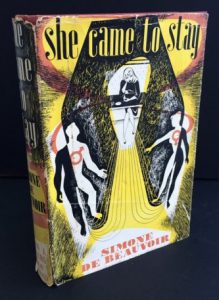As we move forward time, no longer studying the historical backdrop for Existential thinking/art/literature, we will see themes and ideas more densely and fully explored. She Came to Stay (L’Invitee) was published in 1943, placing it a few years before Sartre and Beauvoir explicitly came out and used the brand of Existentialism to publicize their work. This is the same year Sartre published Being and Nothingness, a work which grew out of their shared intellectual pursuits, though Sartre explicitly wrote it.
In She Came to Stay Beauvoir masterfully uses her powers for narrative to approach difficult Hegelian and Heideggarian thinking, offering a keen insight as to the nature of being, and our relationship to others in the world. Beauvoir puts herself and the people around her directly in the novel. Francoise is herself, Pierre is Jean-Paul Sartre, and Xaviere is the real life person of Olga Kosakiewicz. Olga is a younger woman who, in an unconventional way, had joined Beauvoir and Sartre’s relationship in the 1930s. By the end of the novel Francoise, unable to reconcile this relationship, destroys her ‘other’ and brings finality to the story. Given that Beauvoir has publicly said that violence is a possessing of the other, something you can never do, what can we say about Francoise’s actions? Think about this and the other topics brought up in the critical texts for next class.
(Please read them in the listed order)
Simone de Beauvoir and the Ethics of Characters _PHIL 489 presentation (Slides)
She Came To Stay (Part 1)
She Came To Stay (Part 2)
She Came To Stay (Part 3)
Excess and Transgression in Beauvoir’s Fiction (Part 1)
Excess and Transgression in Beauvoir’s Fiction (Part2)
(Optional reading)
Ethics of Ambiguity (Read the first chapter)
If you have time, this article is absolutely fantastic, would suggest looking at it for paper topics!:
